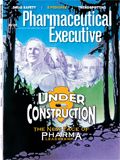Good Tailoring
Pharmaceutical Executive
Personalized health communication enables marketers to vary the messages they deliver, and it increases their ability to motivate different patients to act
Americans have a well-documented appetite for health information. Analysts and others have watched consumers' growing interest in managing their healthcare—a trend supported by the increasing traffic to disease and drug Web sites—and have interpreted it as a symbol of the age of the empowered healthcare consumer.

Jessica DiPaolo
Certainly, knowledge is power. However, according to the American Academy of Physicians (AAP), there are now more than 24,000 medications on the market, each with its own body of clinical and safety information. Consumers must wade through reams of information from disparate sources, spending lots of time clicking around, comparing one site to the next, just to get a handle on the basic health and safety information of a treatment. In this age of the self-motivated consumer, it's no wonder many patients might feel overwhelmed.
According to the National Assessment of Adult Literacy (NAAL), a national literacy study undertaken every decade that for the first time benchmarked health literacy in the United States, one-third of Americans can't read, understand, or act on the most basic medical information. That means, after looking at the label on their medicines, the 75 million US citizens with basic or below-basic health-literacy skills still don't know when or how to take their treatments correctly.
Low health literacy is linked to poor outcomes, including higher rates of hospitalization and death, according to former US Surgeon General Richard Carmona. And in the United States, it is the poorest, least-educated, and most vulnerable populations that have the largest disconnect between information, comprehension, and willingness to act. This is a particularly acute problem for senior citizens, who visit eight physicians and fill an average of 27 prescriptions annually, according to the AAP. This makes seniors the highest users of prescription drugs, yet they have the lowest average health-literacy score among all adults.
Certainly, a long-term view of health literacy should include solutions to increase overall literacy and strategies to empower people to take charge of their health. That being said, pharma companies can make an immediate impact on health literacy by adjusting their marketing approaches and materials to be more patient-centric.
Health Information, for You
Pharmaceutical companies spend billions of dollars to develop, refine, and launch marketing campaigns; identify treatment barriers; and create new messages to promote their brands. But the problem with the broadcast-marketing model is that patients' understanding of and ability to act on marketing messages is not on an even plane.
For example, let's look at the growing therapeutic area of statins, prescribed for cholesterol reduction, which have held a fair share of the DTC market in recent years. According to the American Heart Association, fewer than one-half of people with symptomatic coronary heart disease (CHD) are on a lipid-lowering treatment such as a statin. Despite sizable advertising efforts, many patients remain untreated. Even people exhibiting CHD symptoms, who should be most receptive to statin advertising, have not been converted to treaters.
Newer broadcast DTC messages focus on managing good and bad cholesterol (HDL and LDL, respectively), or treating cholesterol imbalances caused by both a patient's family history and food sources. While this shift in messaging is based on important research and clinical guidelines, the campaigns fail to drive action among a large number of CHD patients.
There are myriad reasons why patients may bypass CHD marketers' messages. Some older patients may feel frustrated by the number of pills they need to take and the degree to which medications disrupt their lifestyles. Other CHD patients may not realize that their cholesterol levels are out of the normal range and could be a contributing factor to CHD. And while overcoming that obstacle is a core challenge for pharma marketers, it is, of course, possible. Just look at the grassroots "Know Your Numbers" health-education campaign: It urges consumers to learn their blood pressure, cholesterol, and blood glucose levels, and it has effectively increased awareness and treatment of hypertension, dyslipidemia, and diabetes in communities supporting the campaign. Key to the campaign's success is close adherence to health-literacy guidelines—using clear, common language and plainly identifying the action to take, why it's important, and specific next steps (testing and follow-up discussions with healthcare providers).
Today, many companies are making headway by creating personalized disease-management programs—what some in the industry are calling "a pill and a plan"—to help patients better navigate the range of factors that affect their health behaviors. Personalized health communication enables marketers to vary the messages they deliver to patients with different needs and abilities, and it increases their ability to motivate different patients to act.
"It's getting harder and harder to justify using only a DTC/broadcast-promotion approach," says Tom Snow, EMD Serono's director of marketing, reproductive health. "Many disease states require more nuanced, complicated relationship-marketing initiatives."
For example, EMD Serono combines offline tactics, like a toll-free number, with online strategies to help patients become more engaged in their treatment plan. "We have created online tools for our fertilitylifelines.com Web site to help people self-navigate to the information that is most relevant to them," Snow says. "For instance, the My Fertility Profile tool asks users a series of questions about age, medical history, and how long they've been trying to conceive, and then generates a customized report."
Other companies are attempting to tackle the emotional barriers to engagement. For example, Lilly includes an interactive video module that explores specific attitudes and beliefs about depression on its cymbalta.com Web site. Unlike typical pharmaceutical Web sites, the language used on the navigational tabs and in the videos reflects the real words that people use to describe their feelings about depression. By avoiding medical jargon and "sanitized" terms, the content is more approachable and more easily understood by people with low health-literacy skills.
Certainly, these tools can be used for health-information seekers. But for brand teams, their return on investment really comes in terms of providing individualized support after a patient sees the physician, so that the tool helps the patient better interpret the physician's care.
Baby Steps
The NAAL findings confirm what many marketers already knew: A much-needed innovation in marketing and patient care will come, in part, from more focused, understandable, and relevant disease information. However, Snow warns that developing these communications can be very resource intensive and, therefore, cost prohibitive. In those cases, pharma companies may decide to reassess current executions rather than reworking entire marketing campaigns.
Some companies have started to personalize their patient brochures and other programs for certain audiences by changing the images and including messages relevant to the target group. Others are tackling health literacy by ramping up the number of delivery platforms (like podcasts, blogs, and text messages) used to disseminate health information, in an effort to bring these messages to a wider audience. But the NAAL study results show a simple truth: Despite innovation in the delivery of these messages, too much drug advertising and healthcare information is not understood.
Instead, the industry must take a critical examination of the content, style, tone, reading level, and layout of its communication. As a first step, companies should ensure their brand messages are understood and actionable by consumers at even very low levels of health literacy. "It's important to take what can be very complex and boil it down to the simplest-possible description," says Anne Myers, patient marketing manager for Lilly's neuroscience portfolio. "Communicate with people at their level."
Companies should also check resources such as the NAAL to see how they can align their marketing pieces with published health-literacy guidelines.
While much of that has to do with pharma's printed communications, perhaps the biggest opportunity comes in interpreting the ethos and execution of health literacy for broadcast TV. "Industry-wide, most of the money—billions of dollars—is being spent on DTC broadcast advertising, which focuses on the exact audience that is having the toughest time figuring out what's going on with their healthcare," says Snow. "That is where the people who are the least health literate are going for their information."
Jessica DiPaolo is manager of strategic services at HealthEd. She can be reached at j.dipaolo@healthed.com
The Misinformation Maze: Navigating Public Health in the Digital Age
March 11th 2025Jennifer Butler, chief commercial officer of Pleio, discusses misinformation's threat to public health, where patients are turning for trustworthy health information, the industry's pivot to peer-to-patient strategies to educate patients, and more.
Navigating Distrust: Pharma in the Age of Social Media
February 18th 2025Ian Baer, Founder and CEO of Sooth, discusses how the growing distrust in social media will impact industry marketing strategies and the relationships between pharmaceutical companies and the patients they aim to serve. He also explains dark social, how to combat misinformation, closing the trust gap, and more.
